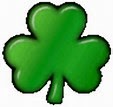What is a Shamrock?
From the writing desk of Christine Mazurk
 I read an article in USA Today yesterday about the Shamrock. "What exactly is a shamrock? No one is quite sure." Pretty fitting since it was St. Patrick's Day. It got me thinking about the history of the day, so I did a little research.
I read an article in USA Today yesterday about the Shamrock. "What exactly is a shamrock? No one is quite sure." Pretty fitting since it was St. Patrick's Day. It got me thinking about the history of the day, so I did a little research.
I know St. Patrick's Day celebrates the Roman Catholic feast day of the patron saint of Ireland, but I didn't know that St. Patrick wasn't Irish. Patrick's birth name was Maewyn, and he was born in Roman Britain. He was kidnapped into slavery and brought to Ireland. He escaped to a monastery in Gual, France and converted to Christianity.
He returned to Ireland in 432 as a missionary. Legend states it was Patrick who confronted the Druids at Tara and abolished their pagan rites. Tradition also states that Patrick used the shamrock or three leaf clover to explain the Trinity. Patrick became a bishop and after his death (March 17, 461) was named Ireland's patron saint.
Eighteenth century Irish soldiers who fought in the Revolutionary War held the first St. Patrick's Day parades, but it was the Irish who emigrated to the U.S. who created the more popular and larger parades we know of today.
Did you know that the practice of dyeing the river green started in Chicago in 1962, when city officials decided to dye a portion of the Chicago river green? The tradition has been carried on for over 50 years!!
Let's get back to the article about the shamrock. Is it a clover? A wood sorrel? Some other type of plant? It was identified as a clover in the 16th century, but there were many types of clovers. In the 19th century, a London botanist insisted it was the wood sorrel. Near the end of that century, an amateur naturalist decided to ask people across Ireland to "identify" the real thing. The most popular responses were the yellow clover and the white clover. In the 1980's, a scientist tried the experiment again and got similar results with the yellow clover taking top spot.
In my opinion, it's a clover and St. Patrick compared the three leaves to the Holy Trinity. Makes the most sense to me. What do you think? Do you get into the facts, the history, or do you simply enjoy downing a Guinness or two? Post a comment and share your traditions.
 I hope you had a safe and fun St. Patrick's Day.
I hope you had a safe and fun St. Patrick's Day.
(Thanks USA Today and gpb.org)
Connect with Christine Mazurk - author on Facebook.
@christinemazurk on twitter
Sign up for my newsletter through www.christinemazurk.com
 I read an article in USA Today yesterday about the Shamrock. "What exactly is a shamrock? No one is quite sure." Pretty fitting since it was St. Patrick's Day. It got me thinking about the history of the day, so I did a little research.
I read an article in USA Today yesterday about the Shamrock. "What exactly is a shamrock? No one is quite sure." Pretty fitting since it was St. Patrick's Day. It got me thinking about the history of the day, so I did a little research. I know St. Patrick's Day celebrates the Roman Catholic feast day of the patron saint of Ireland, but I didn't know that St. Patrick wasn't Irish. Patrick's birth name was Maewyn, and he was born in Roman Britain. He was kidnapped into slavery and brought to Ireland. He escaped to a monastery in Gual, France and converted to Christianity.
He returned to Ireland in 432 as a missionary. Legend states it was Patrick who confronted the Druids at Tara and abolished their pagan rites. Tradition also states that Patrick used the shamrock or three leaf clover to explain the Trinity. Patrick became a bishop and after his death (March 17, 461) was named Ireland's patron saint.
Eighteenth century Irish soldiers who fought in the Revolutionary War held the first St. Patrick's Day parades, but it was the Irish who emigrated to the U.S. who created the more popular and larger parades we know of today.
Did you know that the practice of dyeing the river green started in Chicago in 1962, when city officials decided to dye a portion of the Chicago river green? The tradition has been carried on for over 50 years!!
Let's get back to the article about the shamrock. Is it a clover? A wood sorrel? Some other type of plant? It was identified as a clover in the 16th century, but there were many types of clovers. In the 19th century, a London botanist insisted it was the wood sorrel. Near the end of that century, an amateur naturalist decided to ask people across Ireland to "identify" the real thing. The most popular responses were the yellow clover and the white clover. In the 1980's, a scientist tried the experiment again and got similar results with the yellow clover taking top spot.
In my opinion, it's a clover and St. Patrick compared the three leaves to the Holy Trinity. Makes the most sense to me. What do you think? Do you get into the facts, the history, or do you simply enjoy downing a Guinness or two? Post a comment and share your traditions.
 I hope you had a safe and fun St. Patrick's Day.
I hope you had a safe and fun St. Patrick's Day. (Thanks USA Today and gpb.org)
Connect with Christine Mazurk - author on Facebook.
@christinemazurk on twitter
Sign up for my newsletter through www.christinemazurk.com


Comments
Post a Comment
We would love to hear from you but hope you are a real person and not a spammer. :)